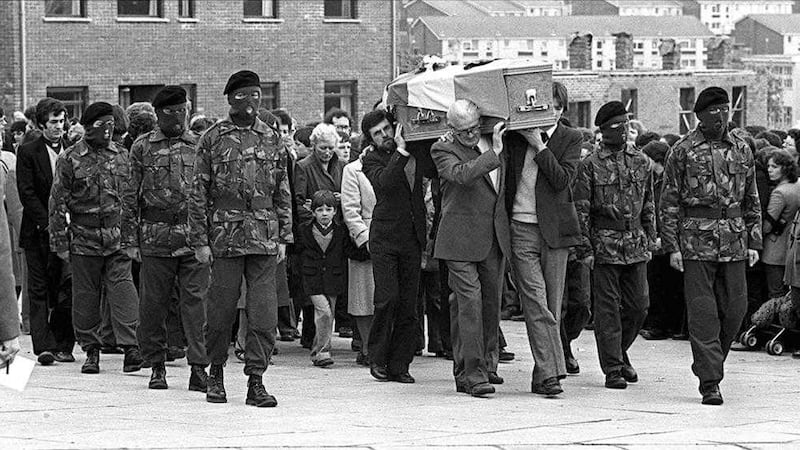THE commencement of the major hunger strike in the H-Blocks on March 1 1981 had significant repercussions.
In the south, IRA and INLA prisoners in Portlaoise were naturally agitated when comrades in Long Kesh sought traditional republican rights as ‘political prisoners’.
Their frustration, however, could be kept in check as the Irish government tacitly permitted the maintenance of paramilitary command structures within the prison.
In a similar manner to Long Kesh, Crumlin Road and Armagh, an IRA ‘officer commanding’ could and did maintain tight discipline on the wings in line with the policies of the IRA army council.
Matters were very different in England where scores of IRA prisoners were scattered across seven maximum-security ‘dispersal prisons’ and additional Special Security Units in Parkhurst and Leicester.
Highly experienced IRA personnel were serving life sentences from Hull in Yorkshire to Albany on the Isle of Wight.
They were rated ‘Category A’ on a scale devised by Lord Mountbatten in 1966 and subjected in consequence to the most stringent forms of incarceration.
Anyone attempting to fulfil the role of an O/C in England was liable to be moved or ‘ghosted’ without notice to a different location.
The ‘first’ Long Kesh hunger strike, led by Brendan Hughes, ended on a sour note in December 1980 when the IRA and Sinn Fein were deceived on prisoners’ rights to wear their own clothes and related matters.
When Bobby Sands was appointed O/C and renewed the fast in March 1981 it was clear that the gambit would terminate in victory or death. This invested the ‘second’ protest with much greater potency.
If uncertain as to the merits of taking drastic action in Long Kesh, the leadership of the republican movement was adamant that no external forces, including their own adherents, would detract from its focus.
The unexpected determination of IRA prisoners in England to join the strike, therefore, necessitated secret intervention.
By 1981 the IRA in the Dispersal System had mounted numerous escape attempts, including a near miss by Gerry Kelly from Wormwood Scrubs.
Republican prisoners had sabotaged workshops, devastated cell block roofs and played leading roles in major riots, not least the 1976 revolt in Hull.
They demanded to be returned to Irish prisons where if political status was not automatically achieved, better terms of remission, parole and visiting conditions were generally available.
Protests in both Irish jurisdictions were carefully monitored in England and many prisoners from the north had relatives and comrades deeply engaged in the Long Kesh campaigns.
They appreciated the brinkmanship of the 1981 strategy and approximately seven men discretely sought permission to commence parallel fasts in Albany and Long Lartin.
The overture was communicated to the highest levels of the republican movement. As in the H-Blocks, a list of names was submitted for assessment on psychological and physical grounds. In line with army council policy, the offer was declined.
Belfast man Tony Clarke, jailed for 14 years in England in 1977, corresponded with Joe McDonnell who had joined, and ultimately perished on, the 1981 protest.
Clarke recalled: "Word came straight back that in no uncertain terms, 'Nobody goes on it'. You were told you were taking away from this [H-Block protest]. You could see the wisdom’."
This was obeyed as no republican in England wished to break ranks. When Sands was elected MP for Fermanagh and South Tyrone in April 1981, the potential of the strike to pressurise London seemed clear.
On April 26 Martin Coughlan, Paul Norney and Billy Armstrong staged an overnight rooftop occupation in Wormwood Scrubs to highlight the crisis. IRA men climbed on to a Long Lartin roof on May 4.
Meanwhile, ‘black flag’ vigils were staged in London, Nottingham, Manchester, Leeds, Glasgow, Durham and elsewhere to maintain momentum.
Yet no immediate gains were made prior to the death of Sands on May 5. IRA prisoners in Parkhurst Special Security Unit staged a three-day fast in protest, an action that did not contravene orders from Ireland.
In Albany life-sentenced Ronnie McCartney reiterated his offer to hunger strike, lodging a will with a solicitor which granted power of attorney to a man trusted to permit him to die in the event of his lapsing into a coma. No family member would be faced with the dilemma.
Other IRA men in Albany reputedly followed suit. While there were myriad political, strategic, moral and practical considerations, the Albany intervention was once again rejected on the grounds that the movement, in the words of McCartney, "couldn’t manage a hunger strike in two places".
When Bik MacFarlane ordered a cessation of the protest on October 3 1981 seven IRA and three INLA men had perished. Although still a matter of controversy, it is clear that the decision to call a halt was certainly not due to a lack of willing participants within the Provisional IRA prison community.
:: Dr Ruán O’Donnell is the author of Special Category – IRA Prisoners in English Prisons Vol. 2 1978-1985 published by Irish Academic Press (www.iap.ie).








